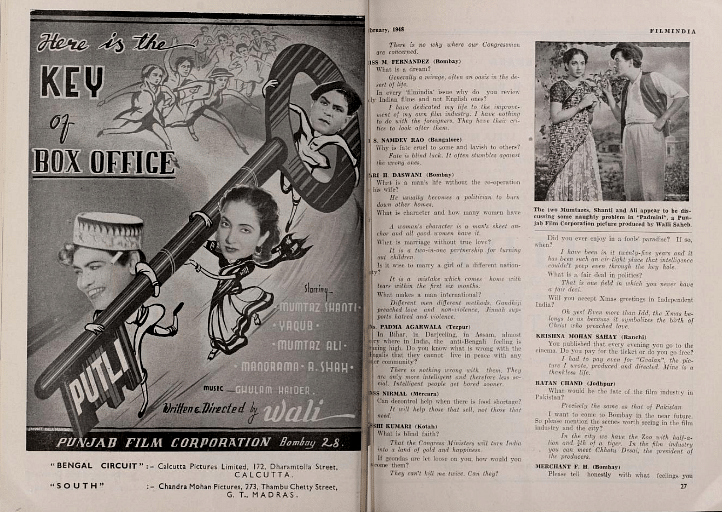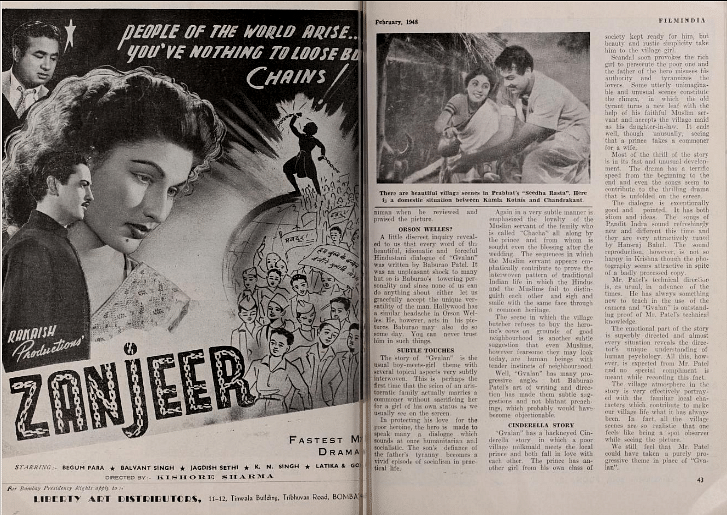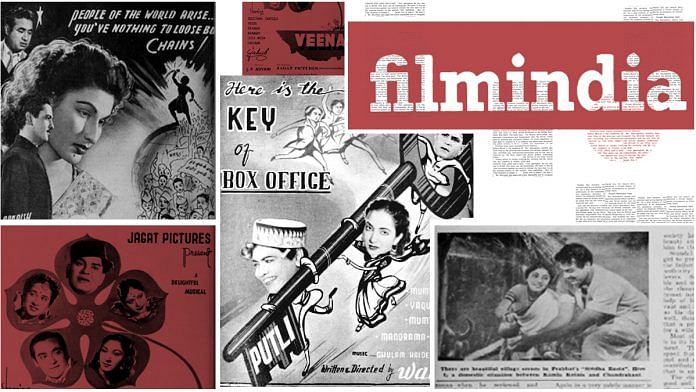The phrase ‘brutally honest’ doesn’t find a better fit than Baburao Patel’s Filmindia, a magazine that used its politically incorrect views to make or break films and stars in the golden years of cinema.
Launched in 1935, Filmindia was known for its harsh, often cruel words that sharply cut through films, actors, directors and didn’t seem to spare a thought for anyone’s feelings. Scandalous headlines like “Avoid Afsar [the 1950 Dev Anand movie] on health grounds”, “11,000 FT OF TORTURE” for Zid (1976) or “A wretched, boring hotch-potch” for Nargis (1946), were what characterised this magazine.
Dev Anand’s 1956 noir film CID was described as an “unpleasant but stupid crime tale” where “Dev Anand fails to look like an inspector even for a single second”, while the film Desh Desi (1935) was compared to “an old pair of trousers made serviceable by bright and coloured patches”. Mala Sinha was called a “potato face”, Suraiya an “ugly duckling”, while G.P. Sippy was simply dismissed as Mumbai’s “foremost producer of trash” — and these were some of the politer criticisms.
But it wasn’t just the reviews that made it popular. The magazine’s Editor’s Mail section, which would often run up to five pages, provided great insights into how devotedly readers followed the magazine. The Picture in Making segment provided a detailed analysis of movies that were currently in production, while the more entertaining Bombay Calling gossip column written under the pseudonym of Judas (Patel himself, many believed) provided salacious nuggets about everyone in the Hindi movie industry.

The magazine was immensely sought-after and Patel’s reviews carried a lot of weight, something he was aware of, says Asha Batra, co-founder of Cinemaazi, a digital repository of Indian cinema. “Baburao was fully conscious of the power of the tool he held with Filmindia.” Sumant Batra, founder of Cinemaazi, adds that while literature in Filmindia may not have been encyclopaedic, it helps one understand cinema “by looking at it from a perspective that opens your mind to the realities of those times”. For him and many others, the magazine remains an integral part of India’s cinema history in how it paved the way for film journalism.
Also read: From DDLJ to Dil Chahta Hai, Bollywood has one act to thank — that one tight thappad
Patel’s complicated legacy
As one of the first film magazines of its time in what was not yet independent India, Filmindia was unmatched in its production quality, using exceptional artists to paint for its covers, the best quality paper and a sophistication that matched many Western publications of the era.
But it is almost impossible to separate the legacy of the magazine from the cult around the larger-than-life figure that was Baburao Patel. While he was known for his cutting, acerbic reviews, he also had his fair share of critics. Some said he angered the powerful of the industry with his scathing words, while others said he was a blackmailer and a bully.
Playwright Habib Tanvir, who happened to be the first assistant editor of the magazine, recalls how Patel once called himself the “goonda of goondas”. Even Manto wrote about his “tough guy assertiveness” and said Patel was sometimes “venomous in a way no other writer in English in India has ever been able to match”.
According to academic Debashree Mukherjee, who dwells on Patel’s persona in her paper Creating Cinema’s Reading Publics :The Emergence of Film Journalism in Bombay, part of his brand was also his constant reiteration of his “self-taught erudition”.
“I was the most educated man in the film industry in those days [the mid-1930s]. And I was a non-Matriculate,” he had once written. As an English-languge magazine, Filmindia appealed to an aspirational and growing-Indian middle class that sought both knowledge and culture, and positioning himself as an intellectual helped Patel create an aura around himself.
It was common to find his photographs in spreads of the magazine alongside Hollywood actresses, wearing well-tailored suits and hats, along with details of his foreign trips. He seemed acutely aware of the growing fascination audiences had with celebrity, and presented himself as someone who not only knew the trade, but also enjoyed an enviable proximity to stars. His hugely popular question-and-answer columns not only displayed his quick wit, but showed how desperately viewers wanted to be on the inside. Sample these:
Q: What is the age of Mumtaz Shanti?
A: Ask me another, I can’t risk this one.
Q. What is the exact relationship between Anuradha and Rafiq Guznavi?
A. Come, I give you the guess.
Q. Why do you have two wives?
A. What is going of your father? Ram Jethmalani was asked by a person personally whether his first wife is happy despite his having a second wife. He answered—Yes my first wife is happier than your only wife.

Also read: C.I.D. — when Bollywood musical met noir in signature Dev Anand style
From Filmindia to Mother India
Baburao Patel never shied away from asserting his political will in the pages of his film magazine. He, along with The Bombay Chronicle‘s Khwaja Ahmad Abbas (who later went on to become a major filmmaker), boldly launched a nationwide campaign against decidedly “anti-Indian” films in 1938. As Mukherjee chronicles, their tirade against “empire films” like The Drum (1938) and Gunga Din (1939), which reinforced imperialist stereotypes of the “racially inferior” and “weak” colonised subjects, resulted in hundreds coming out on the streets of Bombay in protest. Finally, The Drum was withdrawn by its Bombay distributors and then drastically censored. Patel and Abbas went on to set up the Film Journalists’ Association (FJA) in 1939, which further gave them a platform to tackle what they felt were the “menace” of anti-India films.
In 1960, fully cognisant of the detour that his magazine was taking from the course of cinema commentary to politics, he decided to rebrand it from film to social commentary and named it Mother India. Even after his death in 1982, his wife, Sushila Rani, continued to publish the magazine until 1985, its 50th anniversary — something the couple had decided on before he died.
A staunch critic of the Congress, Baburao didn’t mince words when criticising leaders who were hailed as heroes of India’s freedom struggle. In the August 1947 Filmindia issue, he wrote about how independent India would have to “accept Pandit Nehru’s outbursts, Sardar Vallabhbhai Patel’s jibes, Gandhiji’s platonic prayers, and Mrs Sarojini Naidu’s Shakespearean melodrama”, which according to him was “our new ruling aristocracy born in British jails”.
In his Q&A section, a reader asked Patel who was India’s most successful leader, to which he flagrantly answered that it was Mohammad Ali Jinnah because “he got what he didn’t have, others lost what they had.”
Baburao Patel eventually joined politics and even contested the Lok Sabha elections on a Jana Sangh ticket, once unsuccessfully in 1957, but eventually winning in 1967 to become an MP.
The raw and unapologetic content of Filmindia and the brilliance hidden in its pages like lithographs, coloured images of stars and promotional posters of old films have given it cult status in the history of Indian cinema.
Also read: Why Bollywood needs a Parvathy Thiruvothu — an actress not afraid of the F-word







I remember there were when Nargis or some other walked into Baburao Patel’s office and gave him big salp for some scandalous article.
Have a childhood memory of Mother India. There was an Islamic Conference in Rabat, Morocco, where India gratuitously sent a delegation that was chucked out. Baburao Patel had a lot of fun with that.